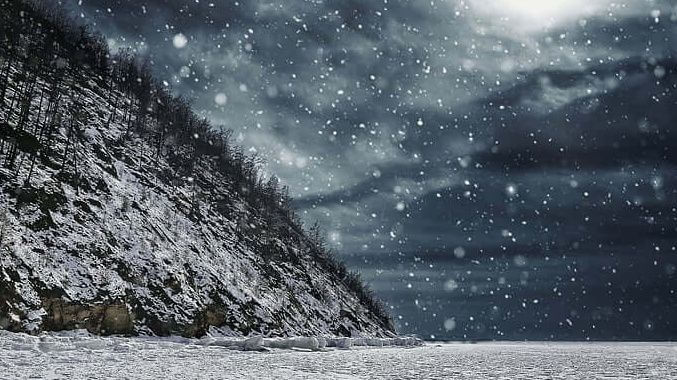Located in the midwest region of the US, Ohio is mainly characterized by a relatively large range of seasonal variability with humid summers and cold winters. The state has its highest elevation as Campbell Hill at 1,549 feet and lowest at the Indiana border at just 455 feet.
Are you planning to explore the beauty of this place in winter and wondering about the average snowfall in Ohio? Keep scrolling the page and take a closer look at more detailed information on snowfall and snowstorms in this Buckeye State.

How often does Ohio Snow?
Snowfall is common in Ohio as most of the state experiences cold, snowy winters. Heavy snowfall is often recorded in this US state, especially between December to March. It receives around 30.4 inches of snowfall yearly, way more than the country’s average. However, snowfall and snow accumulation is lower in the southern parts and average about 6 inches.
When was the last snow in Ohio?
Ohio got the snow in May last year, and this winter is expected to be unseasonably snowy. The first dusting of snow in Ohio typically occurs around Thanksgiving, with an inch or more centered around December. The latest snowfall in Cleveland, Ohio, occurred on May 11, 2020. The earliest snow has come for Ohio is October; however, the chances are pretty rare for such events.
[elementor-template id=”13257″]
Climate in Ohio
Are people moving to Ohio? It is advised to check Ohio’s climatic conditions and avoid last-minute surprises. This Buckeye State enjoys a continental climate, with hot and humid summers and freezing and snowy winters.

Northeast Ohio has four distinct seasons, namely Spring, Summer, Autumn, and Winter. Precipitation in this state varies throughout the year. While the spring and summer months are the wettest, fall and winters are driest in Ohio.
At last, this state can be classified as having a temperate climate, with warm summers and cold winters.
What type of climate does Ohio have?
Ohio has a rich and varied climate. It usually gets affected by warm maritime tropical air masses that bring heat and humidity while producing an occasional cold breeze.
The climate in Ohio is equally exposed to air from Canada, which causes dramatic weather changes daily. Northern countries experience lake-induced weather, while northeastern counties experience a snowy winter.
What’s the weather like in Ohio year-round?
The weather in Ohio isn’t much stable and changes dramatically. Summers are long, hot, and humid, while winters are extremely short but cold, freezing, and snowy. Also, it remains partly cloudy year-round.
What city in Ohio has the best climate?
Toledo, Ohio, experiences the best climate all around the year, with a winter percent of 83, spring percent of 59, summer percent of 38, and fall percentage of 39.
Freezing Days in Ohio
The cold season in the Buckeye state lasts for three months, from December to March. Cities throughout Ohio experience their seasonal freeze, depending on their location.

For example, Columbus, Ohio, remains below freezing all day long from November to March. The city typically has around 28 days when the temperature never rises above 32F.
What’s the coldest month in Ohio?
January is the coldest month in Ohio, with an average low temperature of 24F and a high of 37F.
What is the coldest day in Ohio?
The coldest day in Ohio fell on January 19, 1994, when the lowest temperature measured was -29C.
[elementor-template id=”13252″]
Extremely Cloudy Days in Ohio
While the weather in Ohio remains partly cloudy all year round, there are certain days when you experience extremely cloudy days. It happens because of the state’s location near Lake Erie. Cold and dry air moves over the warmer lake, thus gaining heavy heat and moisture from the lake’s surface. It then mixes with colder air and forms stratocumulus clouds.

The number of cloudy days in Ohio depends on the location of the city. For example, Columbus sees about 190 days of gloomy weather, while Toledo faces 185 cloudy days in total.
How many cloudy days does Ohio have?
Ohio has around 299 cloudy days a year, reflecting 82% of days. Central and Southern Ohio gets between 72 and 77 clear days per year.
Why does Ohio have so many cloudy days?
The cloudy days in Ohio are because of its proximity to Lake Erie.
What is the cloudiest city in Ohio?
Cleveland is the cloudiest city in Ohio, with an average of 299 cloudy days every year. It means that the weather in Cleveland remains cloudy almost the entire year.
What is the cloudiest month in Ohio?
January is the cloudiest month in Ohio. The cloudiest time of year in Ohio begins from November and lasts until June.
Snow fall in Ohio
The average Ohio snowfall by year is about 28 inches, making it one of the snowiest states in the country. The northern part of the state gets more snowfalls than the southern region.

January is the snowiest and coldest month. Chardon is the snowiest town in Ohio that, receives of an average snowfall of 107 inches.
What part of Ohio has snow?
The northern part of the state gets the most snow, with the latest snowfall in Cleveland, Ohio recording up to 18 inches. The average snowfall in northern Ohio is about 11 inches.
Does Ohio get much snow?
Yes. Ohio is ranked among the snowiest states in the United States and gets yearly snowfall of around 28.2 inches.
What months does it snow in Ohio?
January and February are the snowiest months in Ohio, with an average snowfall of 9.5 inches and 7.6 inches of snow, respectively. While you cannot go to Ohio Amusement Park during these months, there are several indoor activities you can enjoy to keep yourself entertained.
[elementor-template id=”13247″]
Snow on the ground in Ohio
Before you check about things to do in Athens Ohio this weekend, it is good to know the snow that Ohio receives every year. Cleveland, Ohio, received 53 inches of snow last winter, which is around 10.8 inches lower than usual.

A recent weather report claims that Ohio winters will be unseasonably snowy this time; hence, visitors and residents should prepare them for it at their earliest.
How many inches of snow does Ohio have?
Ohio receives an average of 11 inches of snow in the northern part and 6 inches in the southern portion.
Conclusion
We hope our guide will help you plan your next trip to this beautiful midwestern US State. Winters in Ohio are usually characterized by snow flurries and freezing temperatures; hence, you are advised to make a trip accordingly.
If you love snowfall and are moving to Ohio from California in the freezing months, plan your visit between December and March and take a scenic drive to see the beautiful winter scenery. This Buckeye State offers plenty of fun things to do during a snowstorm, including sledding, tubing, cross-country skiing, and ice skating.
Why are you waiting? Book your tickets now, pack the right stuff, and make the best out of your Ohio trip.
[elementor-template id=”13242″]